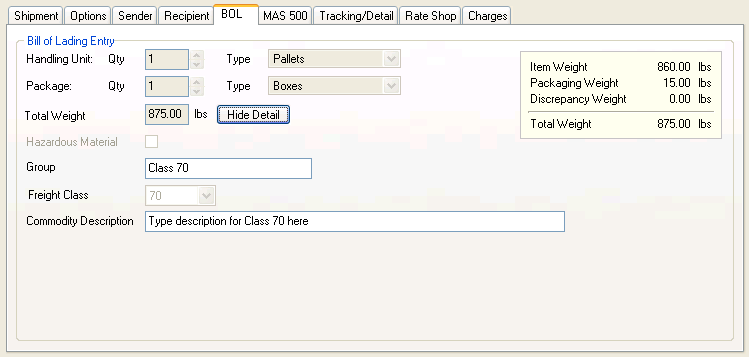StarShip allows you to create shipments against your Sage 500 ERP documents. These are the basic steps to process a new shipment that is initiated from StarShip.
-
You can pack the shipment manually, by clicking the Packaging View button. In the Packaging View, drag and drop the items into first level packaging (for example, Box). See example
-
Line items can be packed using learned or created packaging scenarios (added or modified in Maintain Inventory). If you've shipped any of the items before, StarShip retrieves packaging scenarios and automatically packs those items into first level packaging (boxes, cartons, etc). By default, auto-packing based on packaging scenarios is not enabled. You can enable this setting in Setup > Preferences under Shipment Processing (for Freight or Parcel); check the option, "Automatically pack items based on packaging scenarios." Control how items are packed using the related Auto Pack Preference setting below it.
Note: StarShip supports mixed items in one box. However, Starship can only learn packaging scenarios for future shipments when you have one type of item in one package. The auto-learning of packaging scenarios is optional and can be disabled.
-
Loose items imported from the Sage 500 ERP shipment can be packed automatically into a default box. StarShip will pack loose items into default packaging based on the Preferences setting, "When importing orders, pack all loose items into a default package." This is the default setting; if you want to change this default, uncheck this setting in Parcel or Freight Preferences setup under Shipment Processing. Note that this setting is worded differently for Freight Preferences because it takes pallets into account.
-
If you add items from StarShip inventory, these can be automatically packed into the first, currently selected, or a new default box. They can also be left loose. This is based on the Preferences setting, "When adding items from StarShip inventory, place loose items in ..." The default setting is first package.
-
Items can be packed using the Shipping Assistant, if it is enabled in Preferences setup, either manually or automatically (based on learned packaging scenarios).
-
Some line items may already be packed if you did so in Sage 500 ERP.
-
If any of the shipment items have previously been shipped, StarShip retrieves related freight information (if applicable). If items have not been shipped before, or line item detail is not mapped to Sage 500 ERP, you may need to enter additional information, such as freight class.
-
In the Packaging View, enter the weight of the first box or use an electronic scale to read the weight. If the package weight was imported from Sage 500 ERP, you can skip this step.
-
Click Next to navigate to the next package and repeat the weighing process. If you have the Print on Next feature enabled in Parcel Preferences setup, shipping labels will print for each package as you click the Next button or press Enter. Note : Though the label prints, the shipment is not processed until you press Ship/Process (F5).
Freight Notes
-
Rate the shipment with the currently selected carrier by clicking Rate from the File menu or by pressing Ctrl + Alt + R. To rate shop, click the in the toolbar or press Ctrl + Alt + S. Select a carrier from the Rate Shop tab. For more information, see Shipping Process > Rating in the StarShip Help.

-
If you need to, edit the shipment's Ready Date (and Pickup Time, for Freight) on the Shipment tab.

-
Save the shipment. There are two options for saving shipments.
Save As Draft To save a shipment without processing it, select Shipment > Save, press Ctrl + S, or click the Save button on the toolbar. This action saves the shipment as a draft, but does not process the shipment, request pickup from the carrier, automatically print shipping documentation, or write back any information to Sage 500 ERP. The shipment is essentially saved as a draft so you may open it and make changes.
Ship/Process To process a shipment, select Shipment > Ship/Process or select the Ship/Process button from the toolbar. The shipment is tendered to the carrier. If you set up the bill of lading and/or labels to print automatically, they are now generated. Note: The update to Sage 500 ERP differs depending on where the packaging was created.
After you Ship/Process a shipment, StarShip updates Sage 500 ERP shipments. Note: If "Require Lot/Serial Distribution in Packing" is enabled in the Setup SO Options in Sage 500, StarShip will only update packages for items that either do not require distribution, or have already been distributed in Sage 500.





